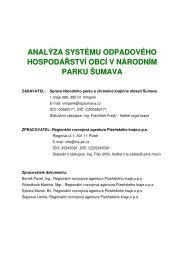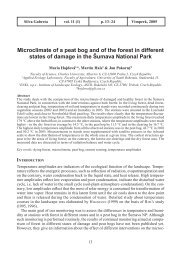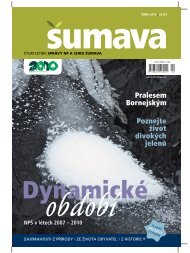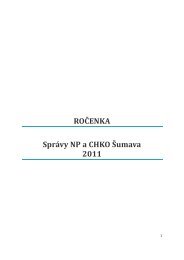(Pseudophilotes baton) (Lepidoptera: Lycaenidae) - Národní park ...
(Pseudophilotes baton) (Lepidoptera: Lycaenidae) - Národní park ...
(Pseudophilotes baton) (Lepidoptera: Lycaenidae) - Národní park ...
You also want an ePaper? Increase the reach of your titles
YUMPU automatically turns print PDFs into web optimized ePapers that Google loves.
Silva Gabreta vol. 14 (3) p. 187–198 Vimperk, 2008<br />
The Baton blue (<strong>Pseudophilotes</strong> <strong>baton</strong>) (<strong>Lepidoptera</strong>:<br />
<strong>Lycaenidae</strong>) in south-western Bohemia: iron curtain,<br />
military ranges and endangered butterfly<br />
Modrásek černočárný (<strong>Pseudophilotes</strong> <strong>baton</strong>) (<strong>Lepidoptera</strong>: <strong>Lycaenidae</strong>)<br />
v jihozápadních Čechách: železná opona, vojenské prostory a ohrožený<br />
motýl<br />
Martin Konvička 1,2, *, Libor Dvořák 3 , Zdeněk Hanč 4 , Alois Pavlíčko 5 & Zdeněk<br />
Fric 1,2,6<br />
1 Institute of Entomology, Biological Centre AS CR, Branišovská 31,<br />
CZ-37005 České Budějovice, Czech Republic<br />
2 Department of Zoology, Faculty Sciences, University Southern Bohemia, Branišovská 31,<br />
CZ-37005 České Budějovice, Czech Republic<br />
3 Šumava National Park Administration, Sušická 399, CZ-34192 Kašperské Hory, Czech Republic<br />
4 Blanský Les Protected Landscape Area Administration, Czech Conservation Authority, Vyšný 59,<br />
CZ-38001 Český Krumlov, Czech Republic<br />
5 Šumava National Park Administration, 1. Máje 260, CZ-38501 Vimperk, Czech Republic<br />
6 Institute of Systems Biology and Ecology AS CR, Na Sádkách 7,<br />
CZ-37005 České Budějovice, Czech Republic<br />
*konva@entu.cas.cz<br />
Abstract<br />
<strong>Pseudophilotes</strong> <strong>baton</strong> (Bergsträsser, 1779) was discovered for the Czech Republic as late as in the 1990s,<br />
because until then, it was confused with its congeneric sibling, P. vicrama (Moore, 1865). We describe here<br />
the circumstances of the discovery and describe the current situation of P. <strong>baton</strong> in the country. The entire<br />
Czech range is restricted to northern foothills of the Bohemian Forest (= Šumava Mts.), where the butterfly<br />
inhabits sparsely-vegetated patches with exposed bedrock and a high density of short-growing cushions of<br />
its host plant, Thymus pulegioides. The butterfly experienced a severe decline, as agricultural intensification,<br />
abandonment and afforestation destroyed networks of once-suitable patches. Currently, it occurs in only<br />
eight atlas grid cells, forming seven colonies/systems of colonies: two at a former village commons, one in<br />
a deserted sand pit, and two maintained by military activities. Administrators of protected landscape areas<br />
should assign the species a top conservation priority, a species action plan involving all potential stakeholders<br />
should be prepared. Close cooperation with the military and other land owners represents the most<br />
promising way to safeguard the species in the country, as it is dependent on early successional habitats that<br />
have to be maintained by proper management.<br />
Key words: butterfly, insect conservation, disturbance, habitat management, land use, range limits<br />
INTRODUCTION<br />
With over 10% of its original species richness extinct and nearly half of it endangered, Czech<br />
Republic’s butterflies are among the most severely endangered ones in Europe (BENEŠ et al.<br />
2002, KONVIČKA et al. 2006) and it is not permissible to tolerate extirpation of any of the<br />
187
Fig. 1. Adult <strong>Pseudophilotes</strong> <strong>baton</strong> butterfly. Boletice military range, S Bohemia, July 2008 (photo A.<br />
Pavlíčko).<br />
remaining species from the country (BENEŠ & KONVIČKA 2008). For specialised species with<br />
highly restricted distribution, efficient conservation action requires thorough knowledge of<br />
habitat needs, understanding the processes that have maintained the respective habitats in<br />
the past, and a pragmatic selection of methods how to maintain the habitats in present.<br />
<strong>Pseudophilotes</strong> <strong>baton</strong> (Bergsträsser, 1779) (Fig. 1) belongs to the most seriously threatened<br />
Czech butterfly species (BENEŠ & KONVIČKA 2008). It displays an Atlanto-Mediterranean<br />
distribution, extending from Portugal across SW Europe to Italy and Bavaria and reaching<br />
its global north-western limit in southern Bohemia, Czech Republic (KUDRNA 2002). The<br />
Czech area of occurrence covers northern foothills of the Bohemian Forest, where the butterflies<br />
inhabit patches of subxerothermic grasslands (BENEŠ et al. 2002). A closely related<br />
eastern vicariant distinguishable on the basis of genital preparation, P. vicrama (Moore,<br />
1865), also occurs in the country, to the north and east from the range of P. <strong>baton</strong>, and these<br />
two distributions do not overlap. All extant P. <strong>baton</strong> populations inhabit staggeringly small<br />
biotope patches, forming colonies of just handfuls of adult butterflies. The species thus<br />
hangs on the verge of extinction, and should be assigned a top conservation priority.<br />
In this contribution, we summarise current state of knowledge of the distribution, life<br />
history and conservation of the species in the Czech Republic. We describe a peculiar history<br />
of discovery of P. <strong>baton</strong> in the country, review what is currently known on the species’<br />
distribution, and pay particular attention to measures necessary for safeguarding its future.<br />
188
RESULTS<br />
Discovery of P. <strong>baton</strong> in Bohemia<br />
The overview of Bohemian (W Czech Republic) <strong>Lepidoptera</strong> by STERNECK (1929) recognised<br />
only one species from the <strong>baton</strong>-vicrama pair, “Lycaena <strong>baton</strong> Bergstr.”, as occurring in the<br />
country. BEURET (1943) reviewed a large material from Central Europe, and reported the<br />
other species, P. vicrama, from Velká Chuchle, now part of Prague (Bohemia), as well as<br />
from the Pavlovské Vrchy hills (SE Moravia). Intrigued by the finding, PACLT & ŠMELHAUS<br />
(1950) explored the possibility that there could have been several species of <strong>Pseudophilotes</strong><br />
in what is now the Czech Republic. They dissected multiple specimens, found only P. vicrama<br />
and concluded that all previous “P. <strong>baton</strong>” records were due to misidentification; however,<br />
they did not work with any south Bohemian material. In subsequent years, all the<br />
publishing authors treated their <strong>Pseudophilotes</strong> findings as belonging to P. vicrama. A single<br />
exception was EBENHÖH (1965), who listed several localities of “P. <strong>baton</strong>” from wider environs<br />
of České Budějovice. However, the author did not conduct genital preparations, was<br />
probably not familiar with the BEURET (1946) and PACLT & ŠMELHAUS (1950) papers, and<br />
simply adhered to STERNECK’S (1929) opinion.<br />
The late L. Havel seriously suspected that south Bohemian “P. vicrama” might belong to<br />
true P. <strong>baton</strong> (pers. comm. to AP; these abbreviations refer to individual co-authors of this<br />
paper). This suspicion grew out of different patterns of voltinism (single-brooded populations<br />
in southern Bohemia, double-brooded elsewhere), differences in biotope use, and the<br />
occurrence of “true” P. <strong>baton</strong> near Regensburg, Bavaria (cf. BEURET 1943). Inspired by L.<br />
Havel, O. Kudrna dissected several south Bohemian specimens in the early 1990s, while<br />
working on the preliminary Czech butterfly atlas (KUDRNA 1994). It was during these dissections<br />
when P. <strong>baton</strong> was confirmed for southern Bohemia, and the Czech Republic. The<br />
finding was reported in KUDRNA (1994), but without the details stated below.<br />
Specimen of P. <strong>baton</strong> dissected by O. Kudrna (private collection of A. Pavlíčko):<br />
1 ♂, Bohemia mer., “Jižní Čechy” [= Southern Bohemia], 20 June 1936, Balatý leg., O.<br />
Kudrna det., AP coll.<br />
1 ♂, Bohemia mer., Chotýčany, 20 June 1929, Zavadil leg., O. Kudrna det., AP coll.<br />
1 ♂, Bohemia mer., Vidov, 6 May 1929, Zavadil leg., O. Kudrna det., AP coll.<br />
1 ♂, Bohemia mer., Polečnice (Boletice Military training range), AP leg. et coll., O. Kudrna<br />
det.<br />
The distribution atlas by BENEŠ et al. (2002) tentatively assigned all the <strong>baton</strong>-vicrama<br />
records from SW Bohemia to P. <strong>baton</strong>. Later on, several further specimens from the region<br />
were genitalised and confirmed as P. <strong>baton</strong> by ZF, ZH, and P. Pech.<br />
Life history observations<br />
The life history of Czech P. <strong>baton</strong> was never systematically studied, but available observations<br />
allow some conjecture. Adults form a single generation flying from May until July,<br />
depending on altitude. The earliest and latest observations known to the Czech recording<br />
scheme are May 6 (1929) (see the record above) and August 1 (1995, Buzice). The larvae<br />
develop on thyme (confirmed: Thymus pulegioides) growing on dry, sun-exposed and wind-<br />
-sheltered locations. Adult females are usually observed settled on short thyme cushions<br />
(oviposition?), whereas males may patrol over them or sit and bask at patches of bare ground.<br />
Taller vegetation in close vicinity is used as shelter. Little is known about larval development;<br />
FIEDLER (1991) classifies this butterfly as facultatively myrmecophilous.<br />
At all recently known sites, the thyme forms loose and short (
Fig. 2. Sites of extant colonies of <strong>Pseudophilotes</strong> <strong>baton</strong> in SW Bohemia, Czech Republic. Top: Boletice<br />
military training range, a track created by vehicle movements, with exposed bedrock and short cushions of<br />
thyme (photo Z. Fric). Bottom: Novohradské Hory Mts., abandoned sand pit, with original exposed-bedrock<br />
patch in the rear, and newly (2008) created patches in the front (photo Z. Hanč).<br />
190
483839404142434445464748495051525354555657585960616263646566676869<br />
49<br />
50<br />
51<br />
52<br />
53<br />
54<br />
55<br />
56<br />
57<br />
58<br />
59<br />
60<br />
61<br />
62<br />
63<br />
64<br />
65<br />
66<br />
67<br />
68<br />
69<br />
70<br />
71<br />
72<br />
73<br />
74<br />
75<br />
extremely sparse vegetation, with exposed bedrock forming 30–50% of the ground projection<br />
(Fig. 2). Such a structure is formed and preserved by repeated mechanical disturbances.<br />
If these cease to operate, the thyme become taller and denser, gradually succumbs to penetration<br />
by grass blades, and ultimately gives up to closed-sward grassland.<br />
Historical and recent distribution<br />
The discovery P. <strong>baton</strong> in south Bohemia initiated revisiting of all historically known localities,<br />
as well as searches for new sites, since the mid-1990s onwards. In 2005–2008, we revisited<br />
the sites known in the 1980s and 1990s, plus multiple potential sites such as xeric<br />
grasslands and abandoned quarries, mainly in wider environs of Dolní Dvořiště, Kašperské<br />
hory, Prachatice, Stachy, and Vimperk.<br />
In the 1990s, the densest concentration of sites existed within the Boletice Military training<br />
range, systematically surveyed by PAVLÍČKO (2001). The butterfly occurred there at a<br />
minimum of four sites, all within 10 km 2 and thus likely interconnected by dispersers. A<br />
further closely situated site was the Na Stráži Nature Monument within the Blanský Les<br />
Protected Landscape Area [PLA]. Another system of colonies existed near Blatná (BOGUSH<br />
2006). Presently (August 2008), the Czech recording scheme contains 91 records of P. <strong>baton</strong><br />
from a total of 27 grid squares (Fig. 3). The area of occurrence is largely consistent with the<br />
Bohemian Forest, and includes the districts of Domažlice, Klatovy, Strakonice, Prachatice,<br />
Český Krumlov, and České Budějovice. The historical vertical range was from 397 m (Vidov),<br />
to 919 m (Pohoří na Šumavě). The present range is 500–800 m.<br />
Conditions and prospects of extant sites<br />
Below we describe the seven extant sites, where we confirmed the species in 2005–2008.<br />
Detailed localisation is not stated to protect the sites from collectors.<br />
Grid cell 6847 (Kašperské Hory) (altitude 750–800 m). A system of largely abandoned<br />
191<br />
7071727374757677787980<br />
7638394041424344454647484950515253545556575859606162636465666768697071727374757677787980<br />
Fig. 3. Grid map of the Czech Republic, showing historical (until 2005, grey filling) and recent (2006–2008,<br />
black filling) distribution of <strong>Pseudophilotes</strong> <strong>baton</strong> in the country.<br />
48<br />
49<br />
50<br />
51<br />
52<br />
53<br />
54<br />
55<br />
56<br />
57<br />
58<br />
59<br />
60<br />
61<br />
62<br />
63<br />
64<br />
65<br />
66<br />
67<br />
68<br />
69<br />
70<br />
71<br />
72<br />
73<br />
74<br />
75<br />
76
pastures covered by subxerophilous vegetation with a rich growth of thyme, situated both to<br />
the E and W of the town. The total area is approximately 4 ha, with several open bedrock<br />
patches. In 2007, it was possible to encounter several dozens (
Fig. 4. Active creation of exposed-bedrock sites in the Boletice military training range. Formerly much<br />
more open vegetation gradually succumbs to succession due to decrease of military training activities, the<br />
photographed bulldozing was carried out as a result of the “gentlemen’s agreement’ between local conservationists<br />
and the Army.<br />
mountain range is a small (0.3 ha) glade at a place of a former sand pit. The site is completely<br />
isolated, its vicinity, up to 2 km, consists of just spruce plantations and humid meadows.<br />
The population hosted about 50 adults in peak flight in 2006 (O. ADAM, pers. comm.). The<br />
owner is sympathetic towards conserving the butterfly. In 2008, upon request by one of us<br />
(ZH), removal of birch seedlings and opening-up the turf has been carried out at fifteen<br />
patches approximately 10×3 m each; further 80 m 2 were cleared of spruce and birch saplings.<br />
Besides benefitting P. <strong>baton</strong>, these measures proved beneficial to another threatened butterfly,<br />
Phengaris arion (Linnaeus, 1758), which co-occurs at this locality.<br />
Grid cells 7451+7452 (Studánky) (altitude 750 m). Rocky outcrops and boulder walls within<br />
otherwise rather intensive cattle pastures. Small colonies appear to be associated with<br />
warm patches on south-facing slopes. The current grazing pressure seems to be optimal, as<br />
the butterflies mainly occur at the rocky sections avoided by the cattle. Long-term threats<br />
include decreased grazing and subsequent overgrown by blackthorn on the one hand, and<br />
increased grazing and subsequent deterioration of colonies on the other hand. We call for the<br />
establishment of a managed reserve and/or negotiating of optimal grazing pressure with the<br />
site owners.<br />
DISCUSSION<br />
The “true” <strong>Pseudophilotes</strong> <strong>baton</strong> was discovered as a new species for the Czech Republic as<br />
late as in the 1990s via dissection of a few collection individuals by O. Kudrna. Circumstances<br />
of the discovery are described here, with more than 15 years delay. From geographic<br />
pattern of occurrence, it appears that the species used to be distributed widely, although not<br />
densely, at the northern foothills of the Bohemian Forest. Northern distribution limits re-<br />
193
main insufficiently known: the sibling P. vicrama is positively known from environs of<br />
Prague and environs of Třebíč (western Moravia). If there had been a past hybrid zone<br />
between the two species, it was interrupted long ago by profound land use changes.<br />
The butterfly has declined from 27 grids cells occupied in the past to just eight cells at<br />
present. However, recent work led to the discovery of several new sites, the rediscovery of<br />
others, and even the detection of the butterfly in a previously unrecorded grid cells. All these<br />
discoveries might imply that the species’ status is not critical and that many undiscovered<br />
populations may exist within the area of occurrence. This, however, does not seem to be<br />
likely. Past authors were not particularly interested in this species, which is, due to its small<br />
body size, patchy distribution and unpredictable timing of flight period (caused by its wide<br />
altitude range), extremely hard to detect. The very fact that unmotivated past authors kept<br />
discovering sites, whereas at present, discovery of each new site requires painstaking focused<br />
searches, suggests a staggering loss of colonies. All existing sites are extremely small,<br />
none exceeds 1 ha, all host at most a few dozens of adults, and the majority of them (except<br />
for Boletice and Kašperské Hory) are extremely isolated.<br />
A persistence of a P. <strong>baton</strong> colony requires an irregular but rather intense disturbance<br />
regime, suppressing the ground vegetation and exposing the bedrock. In a distant past, such<br />
disturbances followed events such as landslides or erosive action of unregulated rivers (LEP-<br />
IDOPTEROLOGEN-AREBITSGRUPPE 1987, EBERT & RENNWALD 1991). In pre-modern cultural landscapes,<br />
suitable conditions existed on erratically used pastures (= village commons). Suitable<br />
sites were not necessarily large and long lived, but existed in a high density, probably allowing<br />
the species to persist in dynamic metapopulations (cf. WAHLBERG et al. 2002). Indeed,<br />
multiple sites still exist until now on former pastures. The twin effects of land use intensification<br />
and abandonment have forced the species to a handful of retreats, where suitable<br />
disturbance regimes persisted for a longer time owing to, e.g., to military (Boletice) or police<br />
force (Dolní Dvořiště, Studánky) activities, mineral extraction (Novohradské Hory Mts.), or<br />
even continuation of grazing. The military/police activities deserve to be highlighted here:<br />
they tend to produce rather severe but irregular disturbances and allowed the butterfly to<br />
survive a long period of complete abandonment of some regions, such as the strip adjoining<br />
Czech-German borders. Positive influences of army activities on insect diversity were described<br />
from other regions as well (e.g., VAISANEN et al. 1994, WARREN & BÜTTNER 2009).<br />
The main reason for losses of past sites was successional overgrowth (e.g., multiple sites<br />
near Blatná, Pohoří na Šumavě, Stachy, Opolenec near Vimperk). Some colonies could have<br />
been lost just due to stochastic processes affecting small populations. For example, the Na<br />
Stráži Nature Monument within the Blanský Les PLA has been appropriately managed during<br />
the 1990s, P. <strong>baton</strong> was regularly observed until 2002–2004, but disappeared in 2005.<br />
The preference for host plants growing as short cushion over exposed bedrock, and associated<br />
dependency on disturbed ground, applies for all <strong>Pseudophilotes</strong> species studied in<br />
some detail, be it P. abencerragus (Pierret, 1837) in Spain (MATTONI 1980), P. barbagiae De<br />
Prins & Poorten, 1982 in Sardinia (LEIGHEB & CAMERON-CURRY 1998, GRILL et al. 2002), P.<br />
sinaicus Nakamura, 1975 in Middle East (HOYLE & JAMES 2006), or P. vicrama in Northern<br />
Europe (MARTTILA et al. 1997). The peculiar requirements also explain an association<br />
between these species and intensive disturbance activities. In Finland, P. vicrama has retracted<br />
only to military training grounds, and has been rescued via purposeful disturbance by<br />
heavy vehicles and prescribed burning, carried out jointly by conservationists and Finnish<br />
military; another conservation action was a release at rocky highway verges (VAISANEN et al.<br />
1994, MARTTILA et al. 1997). P. vicrama has also declined strongly in the Czech Republic;<br />
some of its classical populations, such as those within the city of Prague, have diminished to<br />
handfuls of individuals and display an association with trampled paths crossing calcareous<br />
194
grasslands (KADLEC et al. 2008).<br />
The necessary conditions for preserving P. <strong>baton</strong> in southern Bohemia are appropriate<br />
disturbance regimes at occupied sites, and enlargement/interconnection of the sites. Managing<br />
the sites should consist of scrub removal and securing either occasional grazing, or<br />
mechanical disturbance by vehicle movements. Enlarging the sites should focus on suitable<br />
places near the occupied sites, rather than to the sites themselves. The currently occupied<br />
habitats are so tiny that enlarging them by just a few hectares would in fact multiply the<br />
available habitat area. Establishment of reserves at the occupied sites may help with securing<br />
funds for management.<br />
The Finnish example of cooperation between conservationists and military may guide<br />
future conservation efforts. The Boletice military range offers the most suitable conditions<br />
for large-scale restoration of P. <strong>baton</strong> habitats, because the land is publicly owned, belongs<br />
to the Natura 2000 system, and the Army is responsible for maintaining its favourable conservation<br />
status. Despite these circumstances, a regular cooperation between departments<br />
of Environment and Defence has not materialised yet. Further sites with good potential are<br />
those under administration of PLAs (Černá v Pošumaví and Kašperské Hory); it is necessary<br />
that the butterfly attains a top conservation priority there. For other sites, providing appropriate<br />
management shall require cooperation with private owners. The Novohradské<br />
Hory Mts. site is a good example of an owner’s positive response; similar cooperation should<br />
be sought elsewhere. Given the dependency on disturbed ground, conserving the butterfly<br />
may be reconcilable with some unorthodox profitable enterprise, such as establishment of<br />
horse-riding, moto-biking or four-wheel riding ranges. Efficient and pragmatic measures to<br />
conserve the species in Czech Republic should be applied without delay, and should be backed<br />
by a Species action plan involving all potential stakeholders.<br />
SOUHRN<br />
Modrásek černočárný (<strong>Pseudophilotes</strong> <strong>baton</strong>) patří k našim nejvzácnějším denním motýlům.<br />
Tento atlantomediteránní druh byl pro Českou republiku objeven až v 90. letech 20.<br />
století, do té dobyl zaměňován se svým sesterským druhem modráskem východním (<strong>Pseudophilotes</strong><br />
vicrama), žijícím od střední Evropy po Indii. Výskytu “pravého” P. <strong>baton</strong> na<br />
našem území se od 50. let obecně nevěřilo, potvrzen byl až genitalizací několika jedinců z<br />
jižních Čech Otakarem Kudrnou, autor však nepublikoval detaily svého zjištění, které detailně<br />
uvádíme až zde. Dále uvádíme přehled současného rozšíření v ČR a diskutujeme stav<br />
všech známých lokalit.<br />
Český areál je omezen pouze na jižní a jihozápadní Čechy – v podstatě na teplé okrsky v<br />
širším předhůří Šumavy. Motýl je vázán na místa s řídkou a nízkou vegetací a obnaženým<br />
písčitým, štěrkovitým či skalnatým podkladem, podmínkou jsou bohaté ale spíše nízké porosty<br />
jeho živné rostliny mateřídoušky vejčité (Thymus pulegioides). Historické nálezy pocházejí<br />
ze 26 polí síťového mapování, v současnosti je motýl, navzdory intenzívnímu a cílenému<br />
pátrání z let 2005–2008, znám pouze z osmi širších oblastí, spadajících do osmi polí<br />
síťového mapování. Jsou to Kašperské Hory (pole 6847) – výskyt na bývalých pastvinách,<br />
ohrožen sukcesí; Bavorovské Svobodné Hory (6850) – jediná známá populace v intravilánu<br />
obce; VVP Boletice (7151) – několik mikrolokalit udržovaných vojenskými aktivitami,<br />
ohroženy zarůstáním; Černá v Pošumaví (7250) – předpolí vápencového lomu; Dolní Dvořiště<br />
(7353) – spoře zarostlé partie na pastvinách, na místech bývalých ženijně-technických<br />
zátarasů; Novohradské Hory (7354) – jediná kolonie v bývalé pískovně; Studánky<br />
(7451+7452) – skalky a kamenné záhozy na pastvinách. Další nálezy nelze vyloučit, ale<br />
protože se i v případě stávajících kolonií vesměs jedná o velmi drobné, doslova arové mik-<br />
195
olokality, obsazené jen malými koloniemi, perspektivy motýla to těžko zlepší.<br />
Modrásek černočárný je jednoznačně vázán na ranná sukcesní stadia vegetace, udržované<br />
v dávné minulosti přirozenými disturbancemi (sesuvy, záplavy…), později tradičním hospodařením<br />
v krajině, především extenzívní pastvou. Intenzifikace hospodaření, spontánní zarůstání<br />
krajiny a zalesňování zmenšily a izolovaly jednotlivé kolonie. Modrásek leckde přežil<br />
jen díky aktivitám armády, pohraničníků a těžařů surovin, neboť tyto aktivity<br />
zajišťovaly přítomnost narušovaných plošek v krajině. Dnes jsou i poslední zbytky výskytu<br />
ohroženy sukcesí. Má-li u nás druh přežít, musíme pro jeho lokality zajistit aktivní management,<br />
jakož i zvětšení stávajících biotopů formou výřezů křovin, pastvy a mechanických<br />
disturbancí (ekologická obnova). Jako slibná se jeví spolupráce s armádou ČR (VVP Boletice)<br />
i vlastníky některých lokalit (Kašperské hory, Novohradské hory). Pro tento unikátní a<br />
kriticky ohrožený druh by měl být připraven záchranný program, spočívající na spolupráci<br />
všech zúčastněných stran.<br />
Acknowledgements. O. Kudrna communicated to us detailed circumstances of P. <strong>baton</strong> discovery, butterfly<br />
recorders O. Adam, J. Majer, P. Pech, R. Janák, and J. Skala shared with us their original P. <strong>baton</strong><br />
observations. J. Beneš, A. Bezděk, and P. Bogusch helped us with hardly accessible literature; J. Beneš was<br />
also indispensable for organising surveys of some localities. T. Kadlec acquainted us with populations of P.<br />
vicrama within the city of Prague. Czech Army and the owner of the Novohradské Hory Mts. site are to be<br />
thanked for entry permits and for active participation in preserving the butterfly. Surveys of P. <strong>baton</strong> were<br />
funded by Czech Conservation Authority, Grant Agency of AS CR (KJB600070601), Ministry of Environment<br />
(SP/2d3/153/08) and Ministry of Education (6007665801 and LC06073).<br />
REFERENCES<br />
BENEŠ J. & KONVIČKA M., 2008: Tucet odsouzených: Denní motýli, kterým Natura 2000 nepomůže [The twelve<br />
that are doomed: Vanishing butterflies not protected by Natura 2000]. Ochrana Přírody, in press (in Czech).<br />
BENEŠ J., KONVIČKA M., DVOŘÁK J., FRIC Z., HAVELDA Z., PAVLÍČKO A., VRABEC V. & WEIDENHOFFER Z., 2002: Butterflies<br />
of the Czech Republic: Distribution and conservation I., II. SOM, Praha, 857 pp.<br />
BEURET H., 1943: Philotes vicrama Moore, eine für die Schweiz neue Lycaenide (?). Mitteilungen Schweizerische<br />
Entomologische Geselschaft, 18: 523–525.<br />
BOGUSCH P., 2006: Výsledky faunistického průzkumu vybraných čeledí motýlů (<strong>Lepidoptera</strong>) na Blatensku [Results<br />
of faunistic surveys of selected lepidopteran families near Blatná]. Erica, 13: 67–84 (in Czech).<br />
EBENHÖH J., 1965: Příspěvek k poznání jihočeské fauny Rhopalocer [A contribution to understanding of South-<br />
Bohemian Rhopalocera]. Sborník Jihočeského muzea v Českých Budějovicích, Přírodní vědy, 5: 84–87 (in<br />
Czech).<br />
EBERT G. & RENWALD E., 1991: Die Schmetterlinge Baden-Württembergs, Bd. 2 Tagfalter II. Eugen Ulmer, Stuttgart,<br />
516 pp.<br />
FIEDLER K., 1991: European and North West African <strong>Lycaenidae</strong> (<strong>Lepidoptera</strong>) and their associations with ants.<br />
Journal of Research on the <strong>Lepidoptera</strong>, 28: 239–257.<br />
GRILL A., CRNJAR R., CASULA P. & MENKEN S., 2002: Applying the IUCN threat categories to island endemics:<br />
Sardinian butterflies (Italy). Journal of Nature Conservation, 10: 51–60.<br />
HANSKI I., 2005: The Shrinking World: Ecological Consequences of Habitat Loss. Ecology Institute, Oldendorf/<br />
Luhe, 307 pp.<br />
HOYLE M. & JAMES M., 2006: Global warming, human population pressure, and viability of the world’s smallest<br />
butterfly. Conservation Biology, 19: 1113–1124.<br />
KADLEC T., BENEŠ J., JAROŠÍK V. & KONVIČKA M., 2008: Revisiting urban refuges: Changes of butterfly and burnet<br />
fauna in Prague reserves over three decades. Landscape and Urban Planning, 85: 1–11.<br />
KONVIČKA M., BENEŠ J.. & ČÍŽEK L. 2005. Ohrožený hmyz nelesních stanovišť: ochrana a management [Endangered<br />
insects of non-wooded habitats: Conservation and management]. Sagittaria, Olomouc, 79 pp. (in<br />
Czech).<br />
KONVIČKA M., FRIC Z. & BENEŠ J., 2006: Butterfly extinctions in European states: do socioeconomic conditions<br />
matter more than physical geography? Global Ecology and Biogeography, 15: 82–92.<br />
KUDRNA O., 1994: Kommentierter Verbreitungsatlas der Tagfalter Tschechiens. Oedippus, 8: 1–137.<br />
KUDRNA O., 2002: The distribution atlas of European butterflies. Oedippus, 20: 1–342.<br />
LEIGHEB G. & CAMERON-CURRY V., 1998: Observations on the biology and distribution of <strong>Pseudophilotes</strong> barbagiae<br />
196
(<strong>Lycaenidae</strong>, Polyommatini). Nota Lepidopterologica, 21: 66–73.<br />
LEPIDOPTEROLOGEN-ARBEITSGRUPPE, 1987: Tagfalter und ihre Lebensräume. Arten, Gefährdung, Schutz. Schweitzerische<br />
Bund für Naturschutz, Fotorotar, Egg, 516 pp.<br />
MARTTILA O., SAARINEN K. & JANTUNEN J., 1997: Habitat restoration and a successful reintroduction of the endangered<br />
Baton Blue butterfly (<strong>Pseudophilotes</strong> <strong>baton</strong> schiffermuelleri) in SE Finland. Annales Zoologici Fennici,<br />
34: 177–185.<br />
MATTONI R.H.T., 1980: Preliminary observations on the ecology of <strong>Pseudophilotes</strong> abencerragus (Pier.) and P.<br />
<strong>baton</strong> (Berg.) in Spain. SHILAP Revista de Lepidopterologia, 8: 183–183.<br />
PACLT J. & ŠMELHAUS J., 1950: O zástupci rodu Philotes Scudd. v ČSR [On the representative of genus Philotes<br />
Scudd. in Czechoslovakia]. Časopis Československé Společnosti Entomologické, 47: 45–47 (in Czech).<br />
PAVLÍČKO A., 2001: Vojenský výcvikový prostor Boletice [Boletice military training range]. Zlatá Stezka, 7: 283–<br />
323 (in Czech).<br />
VAISANEN R., KUUSSAARI M., NIEMINEN M. & SOMERMA P., 1994: Biology and conservation of <strong>Pseudophilotes</strong> <strong>baton</strong><br />
in Finland (<strong>Lepidoptera</strong>, <strong>Lycaenidae</strong>). Annales Zoologici Fennici, 31: 145–156.<br />
WAHLBERG N., KLEMETTI T. & HANSKI I., 2002: Dynamic populations in a dynamic landscape: the metapopulation<br />
structure of the marsh fritillary butterfly. Ecography, 25: 224–232.<br />
WARREN S.D. & BÜTTNER R., 2009: Active military training areas as refugia for disturbance-dependent endangered<br />
insects. Journal of Insect Conservation, in press. DOI: 10.1007/s10841-007-9109-2.<br />
197<br />
Received: 30 September 2008<br />
Accepted: 10 October 2008
198


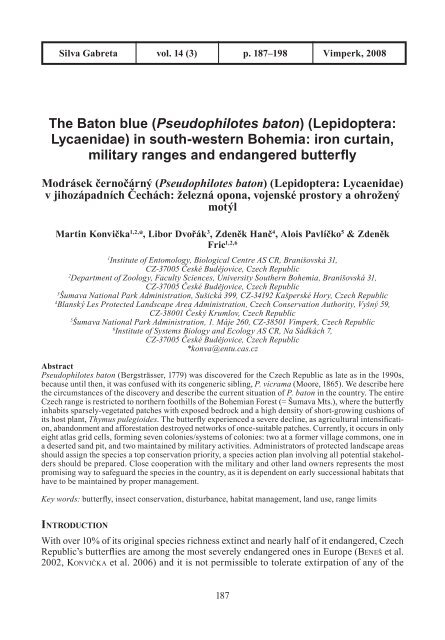
![Zima 2008 [4MB] - Národní park Šumava](https://img.yumpu.com/21236024/1/184x260/zima-2008-4mb-narodni-park-sumava.jpg?quality=85)
